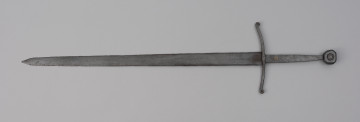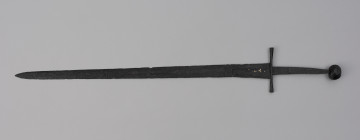
Sword type XIIIa H2 1b (Oakeshott)
circa 1300 — 1350
National Museum in Szczecin
Part of the collection: Militaria
The lengthening of the tang was the next stage in the evolution of the one-handed sword. This type of handle allowed a two-handed grip, with one hand clenched on the tang and the other supported on the pommel. Since the 19th century, this type of sword has been commonly referred to as a one-and-a-half-handed sword, although arms scholars and historians consider this term incorrect. The introduction of an even longer tang made it possible to grip it with two hands. The proper designation with this grip is two-handed sword. The narrowing of the blade in long swords, on the other hand, facilitated the infliction of thrushes (thrusts) and made it possible to pierce chainmail and pierce the joints between the plates of plate armour. Fencing techniques with long swords were displayed in medieval manuscripts from the 14th and 15th centuries, e.g. by Johannes Liechtenauer (active c. 1350-1400) and Hans Talhofer (c. 1410 - c. 1490). They showed not only the handling of classical thrusts and cuts but also a technique based on using the opponent's strength to one's advantage. This resembled wrestling, in which one hand was placed on the tang and the other, with a glove, was supported by the sword's blade. The featured two-handed sword with a curved, broken hilt has a decorated blade with two marks repeated on both sides. It is a cross with a base resembling two hills, interpreted by experts as the symbol of Golgotha, and the letter 'S' ending in a fork and crossed out in the middle with a vertical line. In order to view them, one has to look closely, as the surface of the blade is covered with numerous corrosion resulted pits. Justyna Bądkowska
Author / creator
Object type
two-handed sword
Technique
forging, fine detail finishing
Material
steel
Origin / acquisition method
acquisition
Creation time / dating
Creation / finding place
Owner
Muzeum Narodowe w Szczecinie
Identification number
Location / status

circa 1300 — 1350
National Museum in Szczecin

1300 — 1450
National Museum in Szczecin

1390 — 1430
National Museum in Szczecin
DISCOVER this TOPIC
Castle Museum in Łańcut
DISCOVER this PATH
Educational path